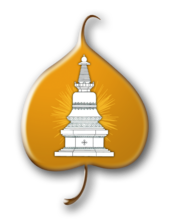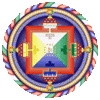Vows and Ordination
![]()
To understand the different types of vows in Buddhism, Mandala Magazine provided this beginner's guide to vows. Traditionally Buddhism avoids proselytizing, so refuge and/or lay vows, and bodhisattva vows are only offered when students request them. In addition, the 24-hour Eight mahaya Precepts should be taken for the first time with a qualified teacher, after which students can take them anytime in front of an altar or image of the Buddha. Kadampa Center holds group precepts on holy days, and one of the Geshes will come and offer them but only if new students request the vows. Requesting any vow ceremonies is done through the Spiritual Program Coordinator (program@kadampa-center.org).
Geshe Gelek recommends anyone interested in taking refuge should read the refuge section in the book Liberation in the Palm of Your Hand (available in our bookstore). He also taught a class on refuge in 2013 for students interested in the ceremony - you can listen to it in the recordings section of our website.
About Ordination
To learn more about ordination, there is a wonderful overview on FPMT's website about preparing for ordination.
Taking the first steps
The following guidance is from the FPMT Handbook:
Prior to requesting ordination, the student is encouraged to discuss their interest with an IMI senior Sangha member (see http://imisangha.org/about-imi/staff) or Kadampa Center's SPC (program@kadampa-center.org) who can facilitate the process and provide guidance.
Background of the Student
Lama Zopa Rinpoche emphasizes the primary consideration in any request for ordination is the relationship of the student with the teacher. The student-teacher relationship is not only
important in determining the suitability of the candidate for ordination at the time of the request but also as the student integrates into the monastic community after taking vows.
While the teacher has the responsibility of deciding the suitability of the student requesting ordination, the decision to ordain is made by the student him (her) self. Prior to requesting
ordination, it is understood that the student will:
• have a foundation in the lam-rim (stages on the path to enlightenment),
• have a firmly established relationship with a spiritual teacher,
• have cultivated an understanding of renunciation in undertaking the life of a monk or nun, and
• have developed the wish to devote their life to service and practice as part of a monastic community.
Students considering ordination should also:
• have had Buddhist refuge for at least five years,
• have lived with lay vows for at least three years,
• not be a Shugden practitioner,
• be at least 20 years of age,
• ideally, have permission from their family,
• be free of any encumbering relationships; if married, the candidate will have permission from their partner and be living separately,
• be free of any encumbering financial obligations,
• not be returning to their ordinary work situation; working in a Dharma center is permissible,
• have held the getsul ordination for at least three years if requesting gelong ordination.



